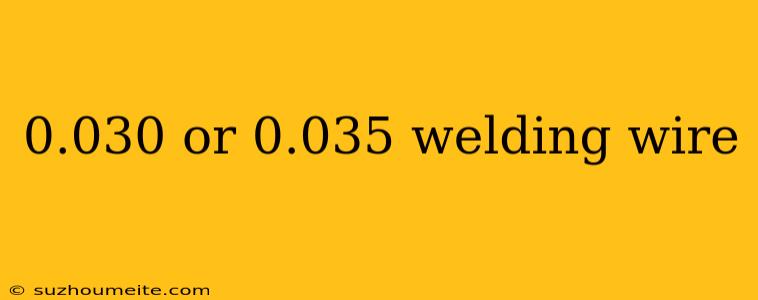0.030 vs 0.035 Welding Wire: Which One to Choose?
When it comes to MIG welding, one of the most critical decisions you'll make is choosing the right welding wire size. Two of the most popular sizes are 0.030 and 0.035, but which one is best for your project? In this article, we'll break down the differences between these two wire sizes and help you decide which one to use.
What is Welding Wire Size?
Welding wire size refers to the diameter of the wire, measured in inches. The thicker the wire, the more metal deposited per pass, resulting in a stronger weld. Thinner wires, on the other hand, produce a smaller weld pool and are better suited for thinner materials.
0.030 Welding Wire
Advantages
- Thinner welds: 0.030 wire is ideal for welding thin materials, such as auto body panels, aluminum, or stainless steel.
- Less heat input: This smaller wire size reduces heat input, making it perfect for sensitive materials that can warp or burn easily.
- Easier to feed: 0.030 wire is easier to feed through the gun, reducing the risk of wire tangles and kinking.
Disadvantages
- Slower welding speeds: 0.030 wire requires slower welding speeds to maintain a consistent weld pool, which can increase production time.
- Less penetrating power: This smaller wire size has less penetrating power, making it less effective for welding thicker materials.
0.035 Welding Wire
Advantages
- Faster welding speeds: 0.035 wire can be welded at faster speeds, increasing productivity and reducing project time.
- Greater penetrating power: This thicker wire size has more penetrating power, making it suitable for welding thicker materials, such as steel plate or pipe.
- Stronger welds: 0.035 wire deposits more metal per pass, resulting in stronger welds.
Disadvantages
- Thicker welds: 0.035 wire produces thicker welds, which can be difficult to clean up and may require additional grinding.
- More heat input: This larger wire size requires more heat input, which can increase the risk of warping or burning sensitive materials.
When to Choose 0.030 Welding Wire
- Thin materials: Use 0.030 wire for welding thin materials, such as auto body panels, aluminum, or stainless steel.
- Delicate welds: Choose 0.030 wire for welds that require minimal heat input and precise control.
- Small welds: This smaller wire size is ideal for small welds, such as those found in electronics or instrumentation.
When to Choose 0.035 Welding Wire
- Thicker materials: Use 0.035 wire for welding thicker materials, such as steel plate or pipe.
- Faster production: Choose 0.035 wire for projects that require faster welding speeds and higher productivity.
- Stronger welds: This thicker wire size is ideal for welds that require maximum strength and durability.
Conclusion
In conclusion, the choice between 0.030 and 0.035 welding wire depends on the specific requirements of your project. Consider the material thickness, desired weld appearance, and production speed when making your decision. By choosing the right wire size, you'll ensure stronger, more consistent welds and optimize your MIG welding process.
